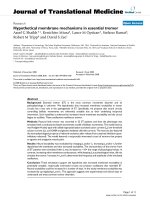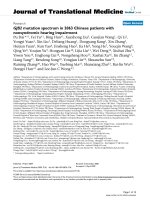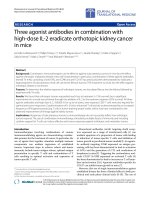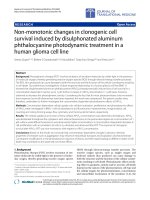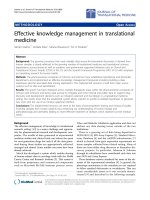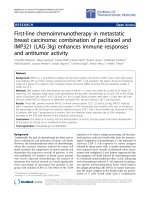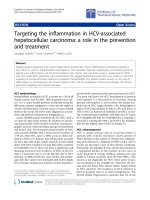báo cáo hóa học: " Improving hand sensibility in vibration induced neuropathy: A case-series" doc
Bạn đang xem bản rút gọn của tài liệu. Xem và tải ngay bản đầy đủ của tài liệu tại đây (238.95 KB, 6 trang )
CASE REP O R T Open Access
Improving hand sensibility in vibration induced
neuropathy: A case-series
Birgitta Rosén
*
, Anders Björkman and Göran Lundborg
Abstract
Objectives: We report a long-term series of nine workers suffering from vibration-induced neuropathy, after many
years of exposure to hand-held vibrating tools at high or low frequency. They were treated with temporary
selective cutaneous anaesthesia (EMLA
®
cream) of the forearm repeatedly for a period up to one year (in two
cases four years). The aim was to improve their capacity to perceive touch and thereby improve hand function and
diminish disability. The treatment principle is based on current concepts of brain plasticity, where a deafferentation
of a skin area results in improved sensory function in adjacent skin areas.
Methods: All participants had sensory hand problems in terms of numbness (median touch thresholds > 70 mg)
and impaired hand function influencing ADL (mean DASH score 22).
After an initial identical self-administered treatment period of 8 weeks (12-15 treatments with increasing intervals)
they did one treatment every 2-3 month.
Results: After one year sensibility (touch thresholds and tactile discrimination) as well as hand function (mean
DASH score 13) were improved in a majority of the cases. Seven of the participants choose to continue the
treatment after the first year and two of them have continued at a regular basis for up to four years. A surpris ing,
secondary finding was diminishing nocturnal numbness of the hand and arm in eight of the nine subjects from
“frequently” to “hardly ever or never” .
Conclusions: Our observations open new perspectives for treatment of impaired sensibility and hand function in a
group of patients with vibration induced hand problems where we have no treatment to offer today.
Introduction
The use of handheld vibrating tools is common in many
occupations where low- as well as high frequency vibrat-
ing tools is used. However, long-term use of vibrating
tools constitutes an occupational health risk, and various
neurological and vasospastic symptoms are common, for
example sensory disturbances, pain, intolerance to cold,
reduced grip stre ngth, and reduced tactile dexterity with
fumbling [1-4]. Hand function may be severely impaired
over the years and may affect the ability to work and
quality of life [5-7]. In the long term perspective vibra-
tion exposure can lead to hand-arm-vibration syndrome,
a complex condition with sensory and musculoskeletal
as well as vascular symptoms [4]. Vibration-induced
neuropathy is sometimes combined with carpal tunnel
syndrome, and it is often difficult to differentiate
between them [8,9]. Apart from ergonomic measures
there is, at present, no effective treatment for the
neuropathy.
Peripheral nerve injury and neuropathy result in
changes in the central nervous system [10,11], and we
have demonstrated, using magnetic resonance technique
(fMRI), that also patients exposed to handheld vibrating
tools and with sensory disturbances in their hands also
show cortical changes with significantly larger activated
cortical volumes and fusion of digital repre sentations in
the primary somatosens ory cortex (S1) [12,13]. The
findings are similar to those in conditions such as h and
dystonia [14,15] with loss of motor control in individual
fingers following long time repetitive synchronous
movements of the digits [15]. Such functional impair-
ments are probably the result of cortical reorganisation
following long-term non-physiological sensory input
[16] and they may also partly explain the symptoms
seen in patients with vibration-induced neuropathy.
* Correspondence:
Department of Hand Surgery, Skåne University Hospital Malmö, Sweden
Rosén et al. Journal of Occupational Medicine and Toxicology 2011, 6:13
/>© 2011 Rosén et al; licensee BioMed Central Ltd. Th is is an Open Access article distributed under the terms of the Creative Commons
Attribution License (http://creativec ommons.org/licenses/by/2.0), which permits unrestricted use, distribution, and reproduction in
any medium, pro vided the original work is properly cited.
All parts of the body are represented in a sensory cor-
tical body map [17] which is constantly modulated in
response to the afferent nerve impulses [18-20].
Increased tactile experience or acute deafferentation of a
body part results in rapid cortical reorganisation [20,21].
Treatment with temporary selective cutaneous anaes-
thesia using an anaesthetic cream (EMLA
®
)containing
2.5% lidocain and 2.5% priolocain, AstraZeneca, Söder-
tälje, Sweden) on the forearm to improve the sensory
function of the hand, is a new method based on rapid
cortical plasticity [22]. The EMLA
®
treatment concept is
an example of guided plasticity [23] where the ability of
the CNS to change is used for therapeutic purposes.
Cutaneous anaesthesia of the forearm results in expan-
sion of the cortical hand area in the S1 and thus more
nerve cells being made available to the hand. In health y
subjects we have used fMRI technique to demonstrate
that cutaneous anaesthesia of the forearm skin induces a
cortical reorganisation, resulting in expansion of the
cortical hand representation. In conjunction with the
cortical expansion the sensory function of the hand
improved significantly [24].
Application of EMLA
®
) to the forearm is a simple and
non-invasive method that results in a deafferentation of
the forearm in the somatosensory cortex which allows
the hand to expand on the forearm area in the S1,
resulting in m ore nerve cells supplying the hand [24].
Clinically the sensory function of the hand improves fol-
lowing EMLA
®
) application to the forearm [ 22,24,25].
The method works in the upper as well as lower extre-
mity in healthy individuals and also enhances the effect
of sensory re-education in patients following peripheral
nerve repair [22,25,26]. Earlier we described application
of the method in a single-case of vibration-induced neu-
ropathy [27]. However, the long-term effect is of
interest, and here we pr esent a series of nine pilot cases
in which the method has been used for up to four years.
Methods
Selection of Cases
During 2006-2009 a total of fifteen consecutive patients
with a history of neuropathy in duced by long t erm
exposure to vibrating handheld tools were referred to
the Department of Hand Surgery in Malmö with the
specific question: “is EMLA
®
treatment a possible way
of improving the impaired hand function?” (Table 1).
They patients had impaired touch thresholds in the
fingers as measured with Semmes-Weinstein monofila-
men ts (> monofilament # 2.83 = 70 mg), and subjective
sensory disturbances with e.g. dyscoordination and
impaired dexterity.
EMLA
®
treatment specifically addresses sensory dis-
turbances, and five of the referred cases were excluded
at an early stage and subjected to further examination
or other treatment, because their problems were not pri-
marily sensory.
After the initial treatment period of eight weeks, nine
of the patients showed improved touch thresholds and
tactile discri mination, they also subjectively experienced
improvement and wanted to continue the treatment. In
onepatientsensoryfunctiondidnotimproveatall-
subjectively or objectively - and there was no wish to
continue the treatment.
In the group of nine patients who wanted to c ontinue
EMLA
®
treatment, four had been exposed to high-fre-
quency vibrating tools (dental hygienists, dental techni-
cians), and fi ve had been exposed to low-frequency
vibrating tools (car or lorry mechanics, road construc-
tion worker). Two of the participants had retired and
seven were in full-time employment, one worked part-
Table 1 Demographic and clinical characteristics at baseline
Subj
nr
Gender Age Years of
exposure
Nocturnal
numbness
Touch threshold at
fingertip level* (g, median)
Tactile discrimination
at fingertip level
(2PD,median)**
Dexterity (Purdue
pegboard) ***
Disability (DASH-
score) ****
1 Female 65 19 frequent 0.07 4 16 9
2 Female 65 25 sometimes 0.4 ≥16 5 33
3 Female 48 29 sometimes 0.16 3.7 16 7.5
4 Female 47 20 frequent 0.16 3.4 13 39
5 Male 64 45 frequent 0.4 4 8 37
6 Male 57 40 hardly ever/
never
0.16 4.3 13 26
7 Male 30 13 frequent 0.16 3.4 18 14
8 Male 37 15 sometimes 0.04 3.4 14 14
9 Male 60 40 sometimes 1.0 10 10 11
* Semmes-Weinstein monofilaments (20 probes 0.008 g - 300 g), normal ≤ 0.07 g
** Two-point discrimination, normal ≤ 5mm
*** Number of pegs picked up and placed during 30 seconds
**** Disability of the arm, shoulder and hand, normal ≤ 10
Rosén et al. Journal of Occupational Medicine and Toxicology 2011, 6:13
/>Page 2 of 6
time for six months in the middle of the treatment per-
iod (subject no 7). Demographics at referral are shown
in Table 1.
The study was conducte d according to the Helsinki
Declaration, the local ethics commit tee approved the
study design, and all participants gave their consent.
EMLA
®
treatment and follow-up
We used a recently presented protocol for treating hand
conditions with diminished sensory function (minimum
protective sensibility) using a treatment programme in
which the skin of the forearm is repeatedl y anaesthetised
by cutaneous application of EMLA
®
cream [25]. Prior to
the treatment a medical history was taken focusing on
adverse effects from prior use of local anaesthetic agents,
including allergic reactions. Vibration-induced neuropathy
is frequently bilateral and EMLA
®
was applied to the arm
subjectively considered to be the most symptomatic. The
cream was applied under an occlusive bandage, for 90
minutes to the flexor aspect of the forearm, over an area
stretching from the wrist and 15 cm proximally. After 90
minutes, the EMLA
®
was carefully washed off.
This initial treatment showed improvement in sensory
functions with improved touch thresholds and/or
improved tactile gnosis (Table 2). The nine persons were
then offered an 8-week treatment period (12-15 EMLA
®
applications in descending frequency) based on self-admi-
nistered treatments and regular follow-ups. This entailed
three treatments in the first week, two treatments in
weeks 2-6, and one treatment in weeks 7-8. Subsequently,
“booster doses” were given once every month over one
year if the patient experienced improvement.
The participants were also instructed to perform a
simple sensory re-education program [28] several times
a day during the initial eight-week treatment period.
Assessment of hand function was performed according
to standardised methods (ASHT, 1992), at regular inter-
vals for up to one year after initiating the treatment.
A full set of 20 Semmes-Weinstein Monofilaments
(SWM) was used for assessment of touch thresholds at
fingertip level, two-point discrimination (2PD) at the
tips of digits II and V for assessment of tactile discrimi-
nation (carried out according to the “Moberg method”
[29]) in a descending order, starting with 15 mm to
assess the level at which responses were correct. Dexter-
ity was assess ed using Purdue Pegboard [29], and grip
strength using Jamar dynamometer [29]. For asse ssment
of disability the DASH (disability of the arm hand and
shoulder) questionnaire was used [30]Assessm ents were
performed prior to and after initial treatment, after 8
weeks, 6 months and 1 year.
Analysis
The majority of the data was ordinal and a nonpara-
metric statistical method - Wilcoxon signed rank test -
was used to calculate the changes in status before trea t-
ment and a fter one year. Due to the small sample size
only two time points - before treatment and after one
year - were calculated.
Result
The results for th e nine subjects after treatment for o ne
year are summarised in Table 2. Touch thresholds
improved significantly (p = 0.01), as did lev el of
Table 2 Result after treatment over 1 year with EMLA
®
cream in nine persons with subjective problems after long-
term exposure to hand-held vibrating tools
Pre
treatment
After 1
treatment
After 8 weeks (15
treatments)
After 1 year (one treatment
every 2-3 months)
Touch thresholds (Semmes Weinstein monofilaments, g)
Normal ≤ 0.07 g median
0.16 (0.04-
1.0)
0.04 (0.04-
0.5)
0.04 (0.04-0.2) 0.04 (0.02-0.07)
Tactile discrimination (2 point discrimination, mm),
normal ≤ 5 mm mean
5.8 (3.4 -
≥16)
3.3 (2.2-5.0) 3.8 (2.8-8.0) 3.1 (2.2-5.0)
Dexterity (Purdue Peg Board, number of pegs picked and
placed), mean
13 (5-18) Not
evaluated
13 (9-18) 15 (10-17)
Disability (DASH-score, normal below 10), mean 22 (8-39) Not
evaluated
Not evaluated 13 (0-32)
Grip strength (Jamar, second position, kg), mean 37 (16-62) Not
evaluated
38 (22-62) 41 (28-67)
Nocturnal numbness (Number of subjects)
Frequently: 4 Not
evaluated
00
Sometimes 4 2 1
Hardly ever/never 1 7 8
Median or mean are registered, and range given within brackets.
Rosén et al. Journal of Occupational Medicine and Toxicology 2011, 6:13
/>Page 3 of 6
disability expressed in a lowered DASH-score (p = 0.03).
A10-pointdecreaseintheDASHscoreisconsidereda
clinically meaningful change [31], and the mean change
in the present study was 9.
Dexterity improved in five of the participants, however
not significantly on group level. No changes were seen
in grip strength.
After one year eight of the nine subjects decided to
continue the treatment with applications of EMLA
®
every 2-3 months.
Subject # 1 has previously been described in a case
report and like subje ct # 5, has now undergone the
treatment with EMLA
®
on a regular self-administered
basis for four years. They, as well a majority of the
group, said that they can “feel” when a treatment is
needed, depending on level of manual activity and sea-
son. Sensory status is normally better during warmer
periods.
Discussion
This case series shows that repeated cutaneous applica-
tion of an anaesthetic cream, EMLA
®
,tothevolar
aspect of the forearm for 90 minutes i n 15 treatments
during an ei ght-week period, results in subjectively, as
well as objectively, improved hand function and reduced
disability in persons with vibration-induced neuropathy.
With booster doses the result lasted at least one year.
After one year eight of the nine subjects to date decided
to continue the treatment with applications of EMLA
®
every 2-3 months, and two participants have c ontinued
treatment for up to four years, maintaining the result.
Extensive simultaneous sensory or motor stimulation
of the digits can produce a use-dependent cortical reor-
ganisation of digital receptive fields. There are se veral
situations where an unfysiological sensory input even-
tually induces a reorganisation of the co rtical hand map
in analogy with that which can be found after long term
work with hand-held vibrating tools [14,32,33]. In such
situations the cortical hand map is distorted and rear-
ranged into a disorganized pattern.
In humans, normal stimulation on the fingers gener-
ated by everyday use of t he hands is non-simultaneous.
Studiesonprimates[16,34]andhumans[35]have
shown that synchro nous stimulation of multi ple digits
results in a b reakdown of the normally sharply segre-
gated representations of adjacent digits in the primary
somatosensory cortex to multiple-digit receptive fields
covering two or three adjacent digits.
We have previously shown, using fMRI at 3T, that the
activated volumes in the hand area of the primary soma-
tosensory cortex were significantly larger in persons
with neuropathy due to long-term exposure to high-fre-
quency vibrations than in healthycontrols.Thenormal
finger somatotopy was changed to a pattern where the
individual fingers overlap each other. Furthermore, acti-
vation in the primary motorcortex was weaker and
more scattered in the neuropathy group compared to
controls [13].
Cutaneous local application of an anaesthetic cream,
where the deafferented area can be precisely controlled,
is a simple treatment. Fol lowing an initial application
session at the hospital, self-a dministration is possible at
home for a well-inf ormed patient. Care has to be taken
as the protective sensation on the forearm is impaired
for a few hours after the application of the cream. The
anaesthetic agent EMLA
®
has been widely tested, and
has no, or few, known side effects [36]. In t he present
group one of the subjects had a rash on the skin for a
few hours after one of the applications. In routine prac-
tice, temporary anaesthesia using EM LA
®
is followed by
rapid and complete normalisation of all sensory func-
tions in the body-part treated [36].
The clinical effect of the deafferentation is already
obvious 90 minutes after application indicating that
unmasking of pre-existing synaptic connections is the
mechanism underlying the rapid modulation of sensory
function [37].
A surprising, but interesting, finding was t hat the
treatment acted positively on carpal tunnel-like symp-
toms such as nocturnal numbness (Table 2), which is a
common problem in vibration-induced neuropathy [8].
Although difficult to explain this is probably also an
effect of the cortical reorganisation induced by the cuta-
neous anaesthesia.
The well-developed feedback system between the hand
and the brain, with continuous proprioception and tac-
tile input that are coordinated with memory system s in
the brain, is a prerequisite for regulation of grip f orce
and grip speed [38] Restoration of this feedback system
is one of the aims after EMLA
®
treatment and possibly
explains the improved functional use of the hand. The
training of discriminative sensibility that is a part of the
treatment - sensory re-education exercises - is possibly
an important factor in such restoration of the fine-tuned
receptive fields in the somatosensory cortex.
Our findings indicate that repeated cutaneous forearm
anaesthesia over an eight-week period can improve hand
function, focusing on sensation. With booster doses of
EMLA
®
once a month after the initial 8-week treatment
we saw a long-lasting effect of up to 4 years in this
group.
In a previous study on patients with median and ulnar
nerve injuries EMLA
®
treatment twice a week for two
consecutive weeks resulted in a significant clinical
improvement lasting at least four weeks after the
EMLA
®
application [25]. The mechanis m behind this is
probably a rapid unmasking of existing neural substrates
but through a repeated deafferentation may create a
Rosén et al. Journal of Occupational Medicine and Toxicology 2011, 6:13
/>Page 4 of 6
more long lasting “ time window” that will enable the
patient to better consolidate the cortical changes thus
producing a longer lasting improvement.
We would like to emphasise that the method
described here, for improving sensory function in work-
ers exposed to vibrating tools, in no way replaces ergo-
nomic measures to minimize such exposure but may
rather be seen as an additional measure.
Our observations open up interesting new perspectives
regarding future possibilities for improving hand func-
tion and reducing disability in a group of patients, for
whom no treatment is available today, using a simple
and non-invasive method.
Our observations are encouraging, indicating a new
principle for t reatment of vibration-induced neuropathy
of the hand, and perhaps also for other neuropathies.
However, this is an initial series of cases in a long-term
study, and the optimal protoco l concerning time, dose,
and practical handling of the cream aimed at achieving
a long-lasting or permanent effect on sensory recovery
has yet to be defined in larger randomized controlled
studies.
Acknowledgements
This work was supported by grants from the Swedish Council for Working
Life and Social Research; the Swedish Medical Research Council; Faculty of
Medicine, Lund University; Malmö University Hospital.
Authors’ contributions
BR carried out the EMLA®) treatment. BR, AB and GL carried out the design
of the study, analysis of data and drafting of this manuscript. All authors
have read and approved the final manuscript.
Competing interests
The authors declare that they have no competing interests.
Received: 25 November 2010 Accepted: 27 April 2011
Published: 27 April 2011
References
1. House R, Wills M, Liss G, Switzer-McIntyre S, Manno M, Lander L: Upper
extremity disability in workers with hand-arm vibration syndrome. Occup
Med (Lond) 2009, 59:167-173.
2. Hagberg M, Burstrom L, Lundstrom R, Nilsson T: Incidence of Raynaud’s
phenomenon in relation to hand-arm vibration exposure among male
workers at an engineering plant a cohort study. J Occup Med Toxicol
2008, 16(3):13.
3. Dahlin LB, Lundborg G: Vibration-induced hand problems: role of the
peripheral nerves in the pathophysiology. Scand J Plast Reconstr Surg
Hand Surg 2001, 35:225-232.
4. Bovenzi M, Griffin MJ, Hagberg M: New understanding of the diagnosis of
injuries caused by hand-transmitted vibration. Int Arch Occup Environ
Health 2008, 81:505.
5. Cederlund R, Iwarsson S, Lundborg G: Quality of life in Swedish workers
exposed to hand-arm vibration. Occup Ther Int 2007, 14:156-169.
6. Cederlund R, Nordenskiold U, Lundborg G: Hand-arm vibration exposure
influences performance of daily activities. Disabil Rehabil 2001, 23:570-577.
7. Poole K, Mason H: Disability in the upper extremity and quality of life in
hand-arm vibration syndrome. Disabil Rehabil 2005, 27:1373-1380.
8. Palmer KT, Harris EC, Coggon D: Carpal tunnel syndrome and its relation
to occupation: a systematic literature review. Occup Med (Lond) 2007,
57:57-66.
9. van Rijn RM, Huisstede BM, Koes BW, Burdorf A: Associations between
work-related factors and the carpal tunnel syndrome-a systematic
review. Scand J Work Environ Health 2009, 35:19-36.
10. Merzenich MM, Jenkins WM: Reorganization of cortical representations of
the hand following alterations of skin inputs induced by nerve injury,
skin island transfers, and experience. Journal of Hand Therapy 1993,
6:89-104.
11. Taylor KS, Anastakis DJ, Davis KD: Cutting your nerve changes your brain.
Brain 2009, 132:3122-3133.
12. Lundborg G, Rosen B, Knutsson L, Holtas S, Stahlberg F, Larsson EM: Hand-
arm-vibration syndrome (HAVS): is there a central nervous component?
An fMRI study. J Hand Surg (European volume) 2002, 27:514-519.
13. Bjorkman A, Weibull A, Svensson J, Balogh I, Rosen B: Cortical changes in
dental technicians exposed to vibrating tools. Neuroreport 2010,
21(10):722-726.
14. Elbert T, Rockstroh B: Reorganization of human cerebral cortex: the range
of changes following use and injury. Neuroscientist
2004, 10:129-141.
15.
Byl NN: Focal hand dystonia may result from aberrant neuroplasticity.
Adv Neurol 2004, 94:19-28.
16. Wang X, Merzenich MM, Sameshima K, Jenkins WM: Remodelling of hand
representation in adult cortex determined by timing of tactile
stimulation. Nature 1995, 378:71-75.
17. Penfield W, Boldrey E: Somatic motor and sensory representations in the
cerebral cortex of man as studied by electrical stimulation. Brain 1937,
60:389-443.
18. Calford MB: Dynamic representational plasticity in sensory cortex.
Neuroscience 2002, 111:709-738.
19. Wall JT, Xu J, Wang X: Human brain plasticity: an emerging view of the
multiple substrates and mechanisms that cause cortical changes and
related sensory dysfunctions after injuries of sensory inputs from the
body. Brain Res Brain Res Rev 2002, 39:181-215.
20. Calford MB, Tweedale R: Acute changes in cutaneous receptive fields in
primary somatosensory cortex after digit denervation in adult flying fox.
J Neurophysiol 1991, 65:178-187.
21. Chen R, Cohen LG, Hallett M: Nervous system reorganization following
injury. Neuroscience 2002, 111:761-773.
22. Bjorkman A, Rosen B, Lundborg G: Acute improvement of hand sensibility
after selective ipsilateral cutaneous forearm anaesthesia. Eur J Neurosci
2004, 20:2733-2736.
23. Duffau H: Brain plasticity: from pathophysiological mechanisms to
therapeutic applications. J Clin Neurosci 2006, 13:885-897.
24. Bjorkman A, Weibull A, Rosen B, Svensson J, Lundborg G: Rapid cortical
reorganisation and improved sensitivity of the hand following
cutaneous anaesthesia of the forearm. Eur J Neurosci 2009,
29:837-844.
25. RosenB,BjorkmanA,LundborgG:Improved sensory relearning
after nerve re pair induced by selective temporary anaesthesia - a
new concep t in hand rehabil itation. J Hand Surg [Br] 2006,
31:126-132.
26. Rosen B, Bjorkman A, Weibull A, Svensson J, Lundborg G: Improved
sensibility of the foot after temporary cutaneous anesthesia of the lower
leg. Neuroreport 2009, 20:37-41.
27. Rosen B, Bjorkman A, Lundborg G: Improved hand function in a dental
hygienist with neuropathy induced by vibration and compression: The
effect of cutaneous anaesthetic treatment of the forearm. Scand J Plast
Reconstr Surg Hand Surg 2008, 42:51-53.
28. Dellon A: Sensibility and re-education of sensation in the hand
Williams&Wilkins Baltimore; 1981.
29. American Society of Hand Therapists (ASHT): Clinical assessment
recommendations
ASHT; 1992.
30.
Beaton DE, Katz JN, Fossel AH, Wright JG, Tarasuk V, Bombardier C:
Measuring the whole or the parts? Validity, reliability, and
responsiveness of the Disabilities of the Arm, Shoulder and Hand
outcome measure in different regions of the upper extremity. J Hand
Ther 2001, 14:128-146.
31. Husted JA, Cook RJ, Farewell VT, Gladman DD: Methods for assessing
responsiveness: a critical review and recommendations. J Clin Epid 2000,
53:459-468.
32. Elbert T, Candia E, Altemnüller E, Rau H, Sterr A, Rockstroh B, Pantev C,
Taub E: Alteration of digital representations in somatosensory cortex in
focal hand dystonia. NeuroReport 1998, 9:3571-3575.
Rosén et al. Journal of Occupational Medicine and Toxicology 2011, 6:13
/>Page 5 of 6
33. Altenmuller E: Focal dystonia: advances in brain imaging and
understanding of fine motor control in musicians. Hand Clin 2003,
19:523-538.
34. Clark SA, Allard T, Jenkins WM, Merzenich MM: Receptive fields in the
body-surface map in adult cortex defined by temporally correlated
inputs. Nature 1988, 332:444-445.
35. Mogilner A, Grossman JA, Ribary U, Joliot M, Volkmann J, Rapaport D,
Beasley RW, Llinas RR: Somatosensory cortical plasticity in adult humans
revealed by magnetoencephalography. Proc Natl Acad Sci USA 1993,
90:3593-3597.
36. Juhlin L, Evers H: EMLA: a new topical anesthetic. Adv Dermatol 1990,
5:75-91.
37. Werhahn KJ, Mortensen J, Van Boven RW, Zeuner KE, Cohen LG: Enhanced
tactile spatial acuity and cortical processing during acute hand
deafferentation. Nat Neurosci 2002, 5:936-938.
38. Johansson RS: Dynamic use of tactile afferent signals in control of
dexterous manipulation. Adv Exp Med Biol 2002, 508:397-410.
doi:10.1186/1745-6673-6-13
Cite this article as: Rosén et al.: Improving hand sensibility in vibration
induced neuropathy: A case-series. Journal of Occupational Medicine and
Toxicology 2011 6:13.
Submit your next manuscript to BioMed Central
and take full advantage of:
• Convenient online submission
• Thorough peer review
• No space constraints or color figure charges
• Immediate publication on acceptance
• Inclusion in PubMed, CAS, Scopus and Google Scholar
• Research which is freely available for redistribution
Submit your manuscript at
www.biomedcentral.com/submit
Rosén et al. Journal of Occupational Medicine and Toxicology 2011, 6:13
/>Page 6 of 6

